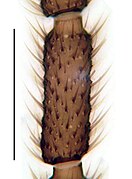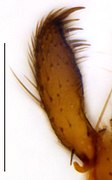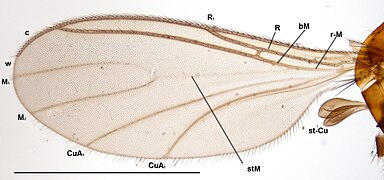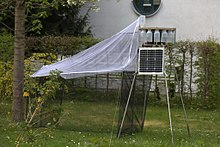Ctenosciara alexanderkoenigi
| Ctenosciara alexanderkoenigi | ||||||||||||
|---|---|---|---|---|---|---|---|---|---|---|---|---|
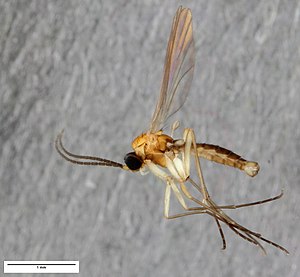
Ctenosciara alexanderkoenigi |
||||||||||||
| Systematics | ||||||||||||
|
||||||||||||
| Scientific name | ||||||||||||
| Ctenosciara alexanderkoenigi | ||||||||||||
| Heller & Rulik , 2016 |
Ctenosciara alexanderkoenigi is one on New Zealand spread of fungus gnats . It was first described in 2016 after a singlespecimen foundin a malaise trap in the garden of the Alexander Koenig Zoological Research Museum in Bonn.
description
The body length is about 2.2 millimeters in the holotype. The body is two-colored, with an orange to reddish thorax and a brown abdomen. Its setae are black and partly elongated and strong, the rear part of the back and the mesothorax are hairless. The abdomen has thick black hair. The hypopygium is about 0.6 times longer than wide and lighter than the abdomen. The gonostyle is elongated, with a length to width ratio of about 3.6 to 1.
The legs are yellowish-white in color, the front legs have an undivided crest with seven to eight bristles. The ratio of length to width of the fourth segment of the antennae is 2.65 to 1, that of its clearly separated, monochrome neck 0.35 to 1. The sensillae of the antennae are shorter than a segment width . The first palpomer has a normal shape, with two bristles and only a few sensils. The second is short and oval, the third as long as the first.
The holders are dark and of normal length. The approximately 2 millimeter long wings are somewhat dark and weakly drawn. The M-fork has a normal shape and the wire R 1 ends well before the base of the M-fork.
Anatomy image gallery
Antennae , fourth flagellomer
discovery
From June 5th to 7th, 2014, an ordinary malaise trap was set up in the garden of the Alexander Koenig Zoological Research Museum in Bonn for test purposes , which was equipped with a prototype of a device for automatically changing the collecting container. When examining the catches from the test period, a sciarid gnat stood out due to its unusual color and morphology , which distinguished it from the known European species of the genus Ctenosciara .
The explorers were initially convinced that they had discovered a new species of Central European fauna. The comparison of the DNA of the holotype with a sequence database revealed the identity with two samples from New Zealand. After using a key to identify New Zealand sciarid gnats , this led to the assumption that the find was the New Zealand species Ctenosciara nigrostyla . The review of the type material of this species led to the conclusion that Ctenosciara alexanderkoenigi is still an undescribed species.
distribution and habitat
The garden of the Zoological Research Museum Alexander Koenig ( 50 ° 43 ′ 19 ″ N , 7 ° 6 ′ 49 ″ E ) was given as the Terra typica of Ctenosciara alexanderkoenigi in the first description . The garden is part of a park of around 7,000 square meters that was laid out in the late 19th century and contains more than 80 mainly non-native trees and bushes.
The original range of Ctenosciara alexanderkoenigi is Australasia , with finds in New Zealand. Ctenosciara alexanderkoenigi was probably introduced from there to Germany not long ago, as the species should have been noticed earlier as an element of the Central European fauna with its striking pattern . It has not yet been clarified whether there is an established population in Bonn or whether the find is just a single animal that was brought in with plant or soil material.
Systematics
Ctenosciara alexanderkoenigi heard as a kind of family fungus gnats (Sciaridae) in the order Diptera (Diptera). Ctenosciara was described in 1960 by the Finnish entomologist Risto Kalevi Tuomikoski as a monotypic genus with Ctenosciara hyalipennis ( Meigen , 1804) . The European fauna is, based on Ctenosciara , with only three described species extremely species-poor. Seven species are known from New Zealand, but in Australia the genus is the defining element of the sciarid gnat fauna, with several hundred species.
Initial description
The first description was made in 2016 by the German biologists Kai Heller and Björn Rulik in the journal Biodiversity Data Journal . The authors only had one male specimen that was caught in a malaise trap in Bonn in 2014 .
Type material
The holotype is an adult male from the type locality that was caught in June 2014. It is in the collection of the Alexander Koenig Zoological Research Museum.
etymology
The authors of the first description used the species name to honor the German zoologist Alexander Koenig (1858–1940), founder of the Bonn Zoological Research Museum Alexander Koenig , in whose garden the species was discovered.
literature
- Kai Heller and Björn Rulik: Ctenosciara alexanderkoenigi sp. n. (Diptera: Sciaridae), an exotic invader in Germany? In: Biodiversity Data Journal 2014, Volume 4, Article e6460, doi : 10.3897 / BDJ.4.e6460 .
Web links
Individual evidence
- ↑ a b c d Kai Heller and Björn Rulik: Ctenosciara alexanderkoenigi , p. 5.
- ↑ Kai Heller and Björn Rulik: Ctenosciara alexanderkoenigi , p. 12.
- ↑ a b c Kai Heller and Björn Rulik: Ctenosciara alexanderkoenigi , p. 2.
- ^ Rainer Hutterer et al .: Park and garden of the Museum Alexander Koenig through the ages . In: Koenigiana 2012, Volume 6, No. 2, pp. 81-99, DocPlayer.org , accessed on December 18, 2017.
- ↑ Kai Heller and Björn Rulik: Ctenosciara alexanderkoenigi , p. 8.
- ↑ Werner Mohrig: The fungus gnats (Diptera: Sciaridae) of Papua New Guinea. Part III - Genera Ctenosciara and Pseudolycoriella. In: Studia dipterologica 2013, Volume 20, No. 1, pp. 123-168.
- ↑ Kai Heller and Björn Rulik: Ctenosciara alexanderkoenigi , p. 1.
- ↑ Kai Heller and Björn Rulik: Ctenosciara alexanderkoenigi , p. 3.
- ↑ Kai Heller and Björn Rulik: Ctenosciara alexanderkoenigi , p. 7.
